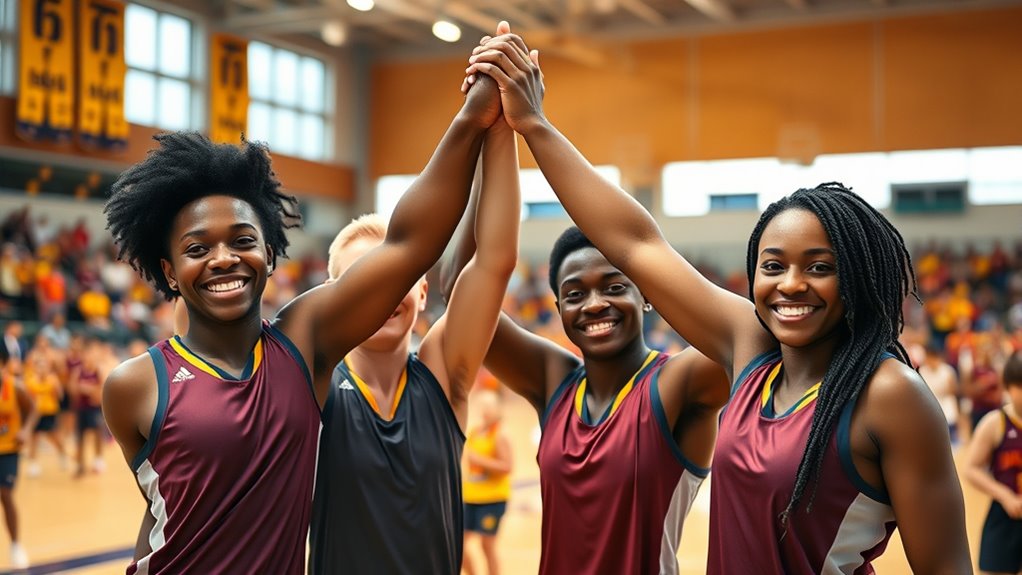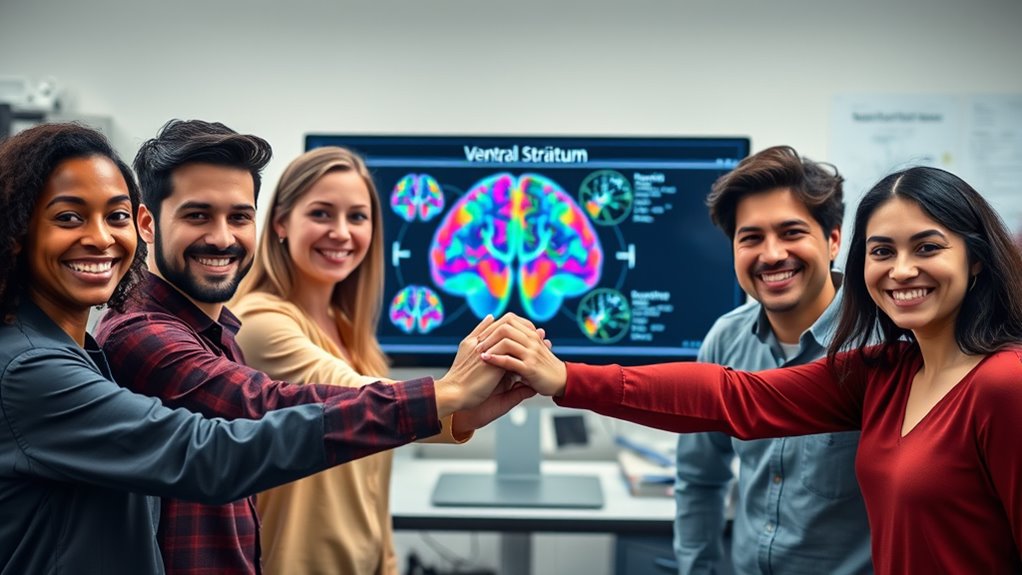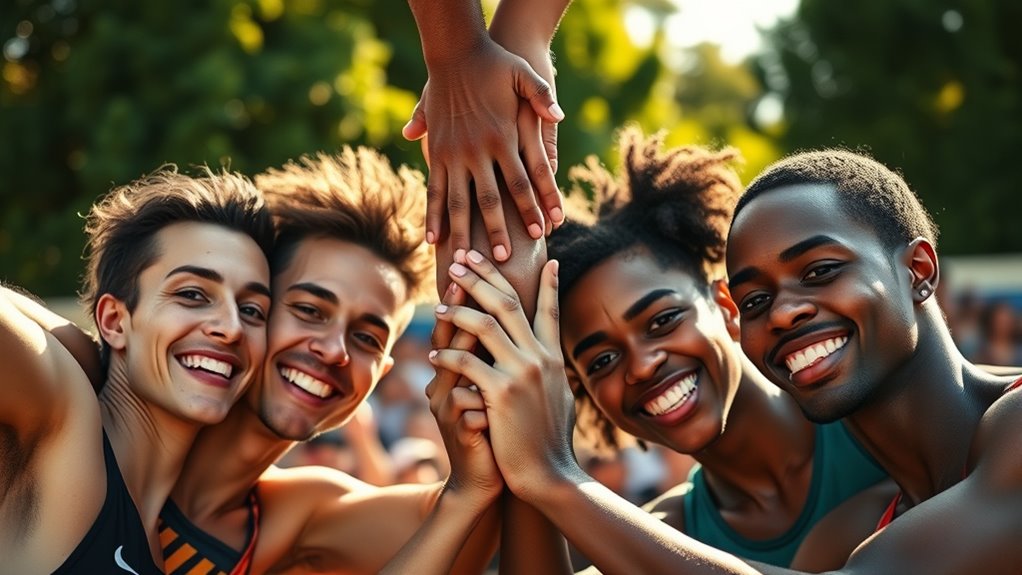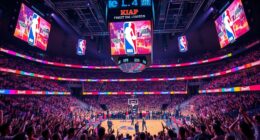When you experience shared victory, your brain activates regions like the medial prefrontal cortex and anterior cingulate cortex, which foster feelings of connection and empathy. The ventral striatum handles the reward aspect, boosting motivation and reinforcing social bonds. Oxytocin release further strengthens trust and cooperation among team members. These neural responses enhance teamwork and create a sense of unity. Exploring these neural mechanisms can help you understand how shared success deeply influences your social and emotional experiences.
Key Takeaways
- Shared victories activate the medial prefrontal cortex and anterior cingulate cortex, reflecting emotional empathy and social recognition.
- Neural synchronization with teammates fosters unity and enhances feelings of connection during shared success.
- Increased activity in the ventral striatum reinforces motivation and positive reinforcement from collective achievements.
- Oxytocin release during shared success promotes social bonding, trust, and group cohesion.
- Neural patterns and synchronization underpin emotional responses, strengthening social bonds and reinforcing team cohesion.
Brain Regions Involved in Social Reward Processing

Understanding the brain regions involved in social reward processing is essential for grasping how shared victories activate our neural circuits. When you experience collective success, areas like the medial prefrontal cortex become active, reflecting emotional empathy and social recognition. These regions help you feel connected and appreciated, reinforcing your sense of belonging. The anterior cingulate cortex also plays a role by processing emotional responses during shared achievements, enhancing your feelings of happiness. This neural activity underscores how social recognition fuels your motivation and bonding. By engaging these brain areas, your brain translates shared accomplishments into powerful emotional experiences. Recognizing these patterns can deepen your understanding of why shared victories feel so rewarding on a neural level. Additionally, understanding the neural correlates can offer insights into how social interactions influence emotional well-being.
The Role of the Ventral Striatum in Collective Success

The ventral striatum plays a key role in how you process rewards during collective success. When your team wins, this brain region activates, boosting your motivation and engagement. Understanding this connection helps explain why shared victories feel so rewarding. Additionally, the activation of the ventral striatum is similar to responses seen with other reward-related stimuli, highlighting its central role in motivating social and individual behaviors.
Reward Processing Dynamics
The ventral striatum plays a central role in processing reward signals associated with collective successes, serving as a key hub in the brain’s reward circuitry. When you experience shared victories, this region responds not only to tangible outcomes but also to emotional empathy, allowing you to feel connected and motivated by others’ achievements. During reward anticipation, the ventral striatum ramps up activity, predicting future successes and reinforcing collaborative effort. This dynamic helps you associate group accomplishments with positive feelings, strengthening social bonds and encouraging continued cooperation. Your brain’s ability to link collective success with reward signals enhances your motivation to engage in teamwork. Additionally, the reward processing mechanisms involve complex interactions with other neural pathways that modulate emotional responses, further amplifying the sense of shared achievement. Ultimately, this process underscores how shared victories activate neural pathways that promote collective motivation and emotional cohesion.
Motivation and Engagement
How does the ventral striatum fuel your motivation and engagement during shared successes? When your group wins, this brain region activates, reinforcing your individual motivation to contribute. It also strengthens group cohesion, making you feel more connected and invested. The ventral striatum’s response to collective achievement boosts your enthusiasm and commitment, turning shared goals into personal rewards. Recognize these emotions with this table:
| Personal Drive | Group Unity |
|---|---|
| Your motivation grows | Bonds deepen |
| Success feels rewarding | Collective pride soars |
| Engagement increases | Motivation sustains |
This neural process sustains ongoing participation, making every shared victory more meaningful. Your brain’s response ensures you stay engaged, motivated, and invested in future group successes. Additionally, social reward mechanisms play a crucial role in reinforcing positive feelings associated with collective achievement.
Neural Activation During Group Achievement Tasks

During group achievement tasks, specific brain regions activate as team members coordinate efforts and share success. You may notice increased activity in areas linked to emotional empathy, such as the anterior insula and anterior cingulate cortex, which help you connect with others’ feelings. Neural synchronization occurs as your brainwaves align with your teammates’, fostering a sense of unity and shared purpose. This synchronization enhances cooperation and reinforces social bonds during achievement. As you work together, these neural patterns reflect both individual emotional responses and collective engagement. The activation of these regions supports the experience of shared victory, making you feel more connected and motivated. Additionally, automation technologies are increasingly integrated into various fields, influencing how team efforts are coordinated and managed. Overall, this neural interplay underpins the deep sense of accomplishment that emerges when a team achieves a common goal.
The Influence of Oxytocin on Social Bonding and Victory

Oxytocin, often called the “bonding hormone,” plays a crucial role in strengthening social connections and enhancing feelings of trust among team members. Its effects extend beyond individual interactions, influencing social bonding mechanisms that foster cooperation and shared success. When oxytocin levels increase, you may notice improved teamwork, trust, and a sense of unity. These effects help explain how shared victories feel so rewarding. Here’s a quick look at oxytocin effects and their impact:
| Oxytocin Effects | Social Bonding Mechanisms |
|---|---|
| Increased trust | Promotes cooperation |
| Reduced stress | Enhances emotional connection |
| Heightened empathy | Strengthens group cohesion |
Understanding these processes reveals how oxytocin underpins the neural basis of shared victory. The release of oxytocin can be triggered by social interactions, further strengthening group bonds during moments of collective achievement.

Neural responses to rewards differ markedly depending on whether the achievement is personal or shared. When you experience a personal reward, brain regions linked to individual motivation, like the ventral striatum, activate strongly, reflecting a focus on personal achievement. In contrast, shared rewards engage areas associated with social bonding and team motivation, such as the medial prefrontal cortex and the temporoparietal junction. This neural response variability suggests that your brain processes personal and team successes differently, influencing motivation levels. Personal rewards tend to produce more intense neural activation related to individual satisfaction, while shared rewards foster cooperation and social connection. Recognizing these differences helps you understand how motivation varies between personal and team contexts, shaping your responses to different types of success. Additionally, understanding AI safety measures in AI development can help mitigate risks associated with shared or personal achievements in automated systems.
Implications for Enhancing Cooperation and Team Dynamics

Understanding how shared rewards activate brain regions associated with social bonding, like the medial prefrontal cortex, reveals opportunities to improve teamwork and cooperation. When team members experience shared success, trust building naturally occurs, strengthening interpersonal bonds. Recognizing these neural mechanisms allows you to foster environments where collaboration thrives. Leaders can leverage this knowledge to develop strategies that promote collective achievement, boosting team cohesion. By emphasizing shared goals and recognizing contributions, you enhance shared neural responses that reinforce cooperation. This approach not only improves immediate team dynamics but also builds a foundation of trust essential for long-term success. Understanding how conflict resolution skills influence neural responses can further optimize team interactions. Ultimately, understanding these neural correlates informs leadership development, helping you cultivate teams that work seamlessly together toward common objectives.
Frequently Asked Questions
How Does Neural Activity Differ Between Competitive and Cooperative Victories?
When you experience a victory, your brain’s activity varies depending on whether it’s competitive or cooperative. In competitive wins, your reward circuitry activates strongly with less emotional resonance, reflecting individual achievement. In contrast, cooperative victories boost emotional resonance and activate shared reward pathways, emphasizing collective success. These differences highlight how your brain processes personal achievement versus teamwork, engaging distinct neural circuits to celebrate either individual or shared accomplishments.
Can Neural Patterns Predict Long-Term Team Success?
Imagine your team’s heartbeat syncing in perfect harmony—neural synchronization mirrors this emotional rhythm. You can’t predict long-term success with just data; emotional synchronization among team members builds trust and resilience. When neural patterns align over time, they foster cohesion, like a symphony reaching its crescendo. So yes, neural patterns can hint at future victories, as emotional and neural synchronization weave a durable fabric for sustained team success.
What Role Do Individual Differences Play in Shared Reward Processing?
You might notice that individual differences, like personality traits and cultural influences, shape how you experience shared rewards. Your personality can make you more or less responsive to team successes, while cultural background influences how you value collective achievement. These differences affect your neural responses during shared victories, meaning your brain processes team rewards uniquely. Recognizing these factors helps explain why everyone might feel differently about shared success.
Are There Specific Neural Markers for Recognizing Shared Achievement?
Have you ever felt that surge of emotional resonance when celebrating a shared achievement? Research suggests that recognizing shared success involves specific neural markers linked to empathy pathways. These markers activate brain areas associated with emotional processing, allowing you to connect deeply with others’ joy. By understanding these neural markers, you can better appreciate how your brain responds to collective victories, fostering empathy and strengthening social bonds.
How Might Neurofeedback Be Used to Enhance Team Collaboration?
You can use neurofeedback to enhance team collaboration by training members to improve brainwave synchronization and emotional regulation. As you practice, you’ll learn to better align your brain activity with your teammates, fostering stronger connection and teamwork. This process helps you manage emotions more effectively, reducing conflicts and increasing cooperation. By consciously regulating your emotions and synchronizing brainwaves, your team becomes more cohesive and productive, boosting shared success.
Conclusion
By understanding the neural nuances of shared victory, you can better boost bonds and build team triumphs. Recognize how the ventral striatum and oxytocin foster feelings of fellowship, fueling future feats. When you harness these harmonious neural highlights, you’ll enhance cooperation, cultivate camaraderie, and create a cycle of collective success. Embrace the power of shared rewards, and watch your team’s trust, teamwork, and triumphs thrive through this brain-based bond.









